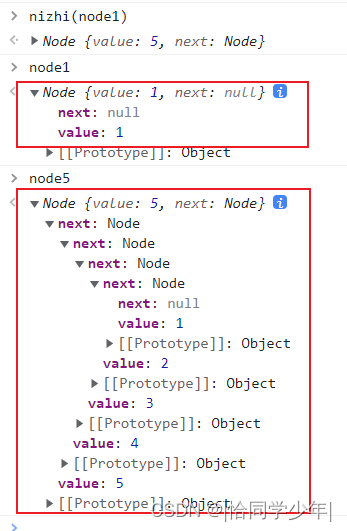链表的逆置
发布时间:2024年01月13日
先准备一个链表
// 定义节点构造函数
function Node(value){
this.value = value;
this.next = null;
}
// 初始化5个node实例
let node1 = new Node(1);
let node2 = new Node(2);
let node3 = new Node(3);
let node4 = new Node(4);
let node5 = new Node(5);
// 将这5个实例串联起来,形成一个链表
node1.next = node2;
node2.next = node3;
node3.next = node4;
node4.next = node5;
/**
* 逆置链表的方法
* @param root 根节点
function nizhi(root){
if(root.next.next === null){ // 代表当前节点(root)是倒数第二个节点
root.next.next = root; // 让最后一个节点指向(root.next)自己(倒数第二个节点)
return root.next; // 递归的出口,返回最后一个根节点(node5);
} else {
let nextNode = nizhi(root.next); // 调用下一个节点
// 如果不是末级(node5),则让下一个节点的next指向自己
root.next.next = root; // (node2的next指向node1;node3的next指向node2;以此类推...)
root.next = null; // node1的next指向null
return nextNode; // 递归结束,返回最后一个被遍历的节点
}
}
// 调用逆置函数
nizhi(node1)
如下图所示,逆置成功

文章来源:https://blog.csdn.net/weixin_42950333/article/details/135563594
本文来自互联网用户投稿,该文观点仅代表作者本人,不代表本站立场。本站仅提供信息存储空间服务,不拥有所有权,不承担相关法律责任。 如若内容造成侵权/违法违规/事实不符,请联系我的编程经验分享网邮箱:chenni525@qq.com进行投诉反馈,一经查实,立即删除!
本文来自互联网用户投稿,该文观点仅代表作者本人,不代表本站立场。本站仅提供信息存储空间服务,不拥有所有权,不承担相关法律责任。 如若内容造成侵权/违法违规/事实不符,请联系我的编程经验分享网邮箱:chenni525@qq.com进行投诉反馈,一经查实,立即删除!
最新文章
- Python教程
- 深入理解 MySQL 中的 HAVING 关键字和聚合函数
- Qt之QChar编码(1)
- MyBatis入门基础篇
- 用Python脚本实现FFmpeg批量转换
- Webpack模块打包工具
- 服务器架构演进史
- 第 2 课 ROS 系统安装和环境搭建
- C++播放音乐:使用EGE图形库
- 虾皮广告数据分析:如何在虾皮(Shopee)平台上进行广告推广
- 【K12】python用科学函数写方程解串联电路问题
- Git学习笔记(第3章):Git常用命令
- 【Java并发】聊聊Future如何提升商品查询速度
- 【UEFI基础】EDK网络框架(MTFTP4)
- 建立java和sql的连接(为聊天窗口添加注册功能)